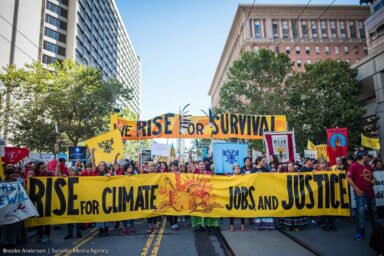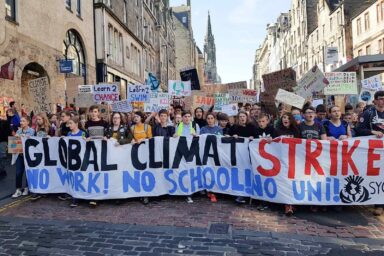Facing Climate Change, Indonesia Still Wants Growth
Indonesia wants to grow economically, but with most of its people still relying directly on the land and minimal goals to fight climate change, plans for a brighter future may backfire.
This story by WhoWhatWhy apprentice reporter Tivara Tanudjaja is produced in partnership with Covering Climate Now, a global journalism collaboration strengthening coverage of the climate story.
Jakarta is sinking. The Indonesian capital is going under faster than any other city in the world — by as much as 10 centimeters per year. Rising sea levels aren’t the only cause. Many of the more than 40 percent of city residents who don’t have access to piped water end up extracting groundwater illegally, resulting in subsidence, where water pumped out of an underground aquifer causes the land above to sink. At the same time, the city is being threatened by flooding aboveground.
“If we look at our models, by 2050 about 95 percent of North Jakarta will be submerged,” Heri Andreas from the Bandung Institute of Technology told BBC News.
But when it comes to climate change, Indonesian President Joko Widodo wants to have it both ways. He has announced a plan to combat climate change — albeit a very weak one — but at the same time, he is doing all he can to boost the nation’s economy by developing infrastructure in ways that harm the climate.
The president, known as Jokowi, has pledged to cut carbon emissions by 2030 to 29 percent below the level that would occur with no change in policy — a goal deemed “highly insufficient” by the Climate Action Tracker, an independent scientific analysis that measures government climate actions — and has offered a tentative proposal to reach carbon neutrality by 2070. With no definite decision from his government and no official actions taken thus far to contribute to the 2070 deadline, it is unclear whether Jokowi is taking carbon neutrality seriously.
Jokowi’s carbon reduction targets, pledged under the international Paris Agreement on climate change, are in line with a warming of 3 to 4 degrees Celsius, whereas the Paris Agreement’s goal is to limit global warming in this century to well below 2 degrees Celsius compared with pre-industrial temperatures. Earth’s average surface air temperature has risen about 1 degree Celsius since 1900, and the result of even that small increase has become evident worldwide.
According to a 2019 report by the Intergovernmental Panel on Climate Change, net global carbon dioxide emissions will need to reach zero around 2050 in order to limit global warming to 1.5 degrees Celsius, and around 2070 for warming of below 2 degrees Celsius.
Indonesia’s Environment and Forestry Ministry Climate Change Management Director General Ruandha Agung Sugardiman said that 2070 is a “logical” timeline for Indonesia to reach carbon neutrality. “We need to consider our national development to maintain economic growth at five to seven percent as well as the population size,” he said in a press conference this year.

And to continue on this track of economic growth, on October 5, 2020, the House of Representatives under Jokowi passed the Omnibus Law on Job Creation. It aims to simplify regulations and eliminate red tape to attract more foreign investors and improve the economy.
Even as thousands of Indonesians took to the streets to protest the bill, fearing that relaxed regulations would limit jobs and income, others criticized the bill for weakening environmental protections by limiting the need for environmental impact analyses.
“This bill is problematic because it contains too much relaxation in labour, environment, licensing, land and others for the sake of attracting investments,” Bivitri Susanti, co-founder of the Indonesian Centre for Law and Policy Studies, said to This Week in Asia.
Jasmine Puteri, former senior forest campaigner at Greenpeace Indonesia, concurred. “Before the Omnibus Law alone, environmental damages had occurred,” she told This Week in Asia. “With this Omnibus Law, it will be even worse.
Jokowi’s infrastructure plans include the construction of new toll roads, railways, airports, and power plants. He also plans to move the nation’s capital from Jakarta to North Penajam Paser, East Kalimantan, about 1,200 miles away, on a different island closer to the center of Indonesia. The move is to be completed by 2024.
“This is for the realization of economic equity and justice,” Jokowi said during a state speech at Parliament in 2019. “This is for the vision of an advanced Indonesia. An Indonesia that lives forever.”
“We cannot let Jakarta and the island of Java continue to bear the increasingly heavy burden in terms of population density, traffic jams that are already severe, and air and water pollution that we have to deal with immediately,” Jokowi said in a conference in 2019.

Toll roads would connect the new capital to more rural areas of Indonesia, boosting the country’s smaller cities but causing the areas between them to become more industrialized.
“Urbanization and the building of more infrastructure is a double-edged sword,” Institut Teknologi Bandung Professor I Gusti Ayu Andani said. “On one hand, it increases the flow of logistics … and the movement of people and objects becomes much easier. On the other hand, it opens up opportunities for many activities. For example, what was once open green space has become something else. If we just look at the area between Bandung and Jakarta, there are a lot of new industrial areas.”
Although constant development may improve the nation’s economy, it has affected the environment, most clearly in Jakarta, in the province of Java, home to more than half of Indonesia’s people.
The current capital is interlaced with roads, both on the ground and in the air. The government has built elevated roads to make up for the increase in traffic and population. But with the loss of open green space, Jakarta is increasingly prone to flooding.
The city currently has 9.9 percent open green space, but it needs 30 percent to effectively absorb water — a goal Jokowi’s government is working toward by 2030. The government has made efforts to normalize rivers — to increase their width and channel capacity — and implement zoning guidelines, but it can only do so much.
According to regulations set by the minister of public works, the local government is obliged to provide 20 percent of green open space and the remaining 10 percent must come from the private sector. These efforts can come in the form of roof gardens, creating parks around the city, and planting greenery beside roads and highways.
“It’s actually not just the role of the government, but also the role of private sectors and citizens to uphold that limit,” Andani said. “For example, when we are building a house, we cannot use up 100 percent of our land for development. We have to leave some space for greenery. So we have our own contribution to that target.”

Although rooftop and vertical gardens are becoming increasingly common, Andani said, the effects of the lack of green space are still being felt.
“It’s like the devil’s circle,” Andani said about the impact that infrastructure and climate change have on each other. Building infrastructure will decrease the open green space, thereby increasing temperatures and severity of flooding within cities. Severe flooding and heavy rainfall will then obstruct infrastructure — houses, roads, and sidewalks.
In January 2020, Jakarta experienced one of its worst floods. The newly finished elevated Jakarta–Cikampek (or Japek) toll road — built to shorten travel time between Jakarta and Bandung and to help cars avoid flooding — flooded.
“Nobody expected and predicted that the rain would amount to that much,” Andani said, “so the planned drainage system was not enough.”
The toll road had to be fixed with a better drainage system.
An increase in temperature means more evaporation and more precipitation. Indonesia receives far more rain than most countries — about 105 inches per year. As global temperatures increase, rainfall will become heavier and flooding will increase.
“So while we want to grow the city and grow economically, let’s not forget about building more green open spaces,” said Afifah Bijaksana, CEO of Solusi Banjir, an organization focused on finding solutions for flood management and water conservation. “Because ‘concretization’ is increasing, let’s also not forget about increasing the areas of water absorption too.”

New development has also affected water quality. According to a 2018 study published in the Journal of Natural Resources and Environmental Management, the 2013 construction of the Mandara Toll Road in Bali, built over water to ease access around the province, resulted in a rise in average water temperature by 0.4 degrees Celsius, a decrease in average pH levels by 0.57, and a decrease in average salinity by 3.88 percent. Sedimentation also increased, affecting tide levels in certain areas and the velocity of ocean currents.
According to the study, the toll road partially blocks an already narrow path for ocean currents to flow from the mouth of Benoa Bay to the mainland. Many aquatic creatures depend on fast currents to carry food and oxygen. According to the report, a decrease in current velocity also results in increased sedimentation. Too much sedimentation can damage mangroves by burying their roots and converting swamp to land. This occurred in the mangrove systems of the Segara Anakan area in south central Java.
Road-building isn’t the only cause of environmental problems. Cities are already subject to higher temperatures than outlying areas, a phenomenon called the urban heat island effect. Building more infrastructure, especially anything with asphalt or concrete, compounds that effect.
“When we talk about asphalt or concrete, in the daytime it will somehow absorb all the heat received from the sun,” said urban climate scientist Nisrina Darmanto. “Then, during the nighttime, [the heat] will be reflected back as long wave radiation.”
Darmanto and other scientists found that urban landscapes could become even hotter than global temperature predictions set by the IPCC.
“Focusing on Jakarta, we concluded the urban effect can add 1.5 to 2.5 degrees Celsius of temperature increase compared to the global scenario. In some places, it can reach up to four degrees,” Darmanto said.
With this rise in temperature, Darmanto’s research found, the mortality rate in Jakarta residents over age 65 will rise around 20 percent within 50 years, “especially where the air circulation is not good, or people cannot afford an air conditioner.”

Constant development and cutting down green areas to expand urban cities for the sake of economic growth may not be sustainable. With a country heavily dependent on its natural ecosystems and resources, environmental factors should also be taken into consideration when talking about economic growth.
Adi Gangga is a researcher at Inobu, an Indonesian non-profit research institute that helps communities of farmers use the land in a sustainable way.
“When we talk about climate change … they will be the most vulnerable communities,” Gangga said. He has had people tell him the water level in the rivers they depend on has decreased over the years. “[In] rain-fed agriculture, where they depend on the rain … if it’s the only option of their livelihood, that’s going to be a problem.”
Prolonged droughts, severe rainfall and flooding, loss in biodiversity, and rising sea levels will put a majority of Indonesia’s citizens in danger, since around 60 percent of the population live in low-lying coastal areas.
That is why an environmentally friendly solution to economic growth is needed.
According to a report by the Ministry of National Development Planning of the Republic of Indonesia (BAPPENAS), a booming economy is possible even with a low-carbon approach.
If the nation follows a low-carbon plan, the report predicts a 4.2 percent reduction in poverty by 2045, a 43 percent reduction in greenhouse gas emissions by 2030, and a growth in gross domestic product of 6 percent per year between 2019–2045.
At the Indonesia Net-Zero Summit 2021 held on Zoom, Suharso Monoarfa, the nation’s minister for national development planning, spoke about the effects of climate change and proposed four different targets for Indonesia to reach carbon neutrality: 2045, 2050, 2060, and 2070. Scenarios reaching net-zero emission by 2045 and 2050, he said, “require an additional area of 300-350 thousand hectares (740 to 865 thousand acres) and a 250 thousand hectare (618 acres) increase in reforestation” as well as “an increase in energy efficiency levels reaching 6 to 6.5 percent by 2050.”
“Often, efforts to reduce greenhouse gas emissions are collided with efforts to promote better economic growth,” Monoarfa said. “But in reality, the reduction of greenhouse gas emissions with a low-carbon development strategy, will actually support a higher economic growth.”
Monoarfa also emphasized that net-zero emissions are necessary if Indonesia is to escape the middle-income trap before 2045, an economic situation in which a country gets stuck at a certain level of income. Monoarfa stated that Indonesia has been stuck as a “lower middle income” country since 2002, and a net-zero goal is the most “sustainable solution” to economic growth.
Although Monoarfa argued that it would be best to reach net-zero emissions by 2045 or 2050, BAPPENAS will present all four options to Jokowi, in whose hands the final decision lies.
“Whatever the decision may be, it will require or encourage very fundamental changes and accelerate the transition to sustainable energy and land use in a holistic and integrated manner with other developmental goals,” he said.
In the absence of government action, some companies are setting their own green goals. In May 2021, Indonesian utility company Perusahaan Listrik Negara stated that it is aiming to phase out fossil fuels to reach carbon neutrality by 2060. Although this is a big step, without support and a clear plan to reach carbon neutrality from the government, it may be a difficult target to reach.
Environmentalists and experts hope that Indonesia has learned from past mistakes, especially in Jakarta, but they stress that the government and the public must have the will to follow through with any plans that would fight climate change.
“The sustainability of planning implementation is lacking in Indonesia,” Darmanto said. “Maybe it’s because BAPPENAS is not involved in the implementation stages, so that’s when things get complicated — in the middle, that’s when most of the political stuff and money stuff come in. There’s a lot of stakeholders who want to win — they want to get much more money — so that’s where this needs to be corrected.”




